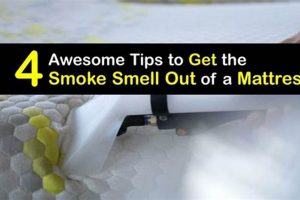The presence of undesirable smells emanating from a sleeping surface presents a common household concern. Addressing this issue typically involves a multi-faceted approach employing cleaning agents and ventilation techniques to neutralize the source of the malodor.
Maintaining a fresh and clean mattress significantly contributes to improved sleep hygiene and overall well-being. Historically, various methods have been employed, ranging from sun exposure to the utilization of absorbent materials, reflecting an enduring desire for a comfortable and odor-free sleep environment. The benefits extend beyond mere comfort, impacting potential allergen reduction and promoting a healthier indoor atmosphere.
Effective strategies for mitigating mattress odors encompass several key areas, including identifying the source of the smell, selecting appropriate cleaning products, and implementing preventative measures to inhibit future occurrences. The subsequent sections will delve into specific techniques and recommendations for achieving optimal results.
Effective Strategies for Odor Elimination from Mattresses
The following provides a series of recommended practices for addressing and removing unwelcome odors from mattresses, enhancing their cleanliness and longevity.
Tip 1: Ventilate the Mattress. Place the mattress in a well-ventilated area, ideally outdoors on a dry, sunny day. Direct sunlight can act as a natural disinfectant and deodorizer. This facilitates the evaporation of trapped moisture and dissipates lingering smells.
Tip 2: Apply Baking Soda. Liberally sprinkle baking soda over the entire surface of the mattress. Baking soda is a natural absorbent that effectively neutralizes odors. Allow the baking soda to sit for several hours, or preferably overnight, to maximize its effectiveness.
Tip 3: Vacuum Thoroughly. After the baking soda has had sufficient time to absorb odors, vacuum the mattress thoroughly using an upholstery attachment. Ensure all baking soda residue is removed. Repeat the baking soda application and vacuuming process if necessary.
Tip 4: Utilize a Mattress Protector. Employ a high-quality, waterproof mattress protector. This acts as a barrier against spills, stains, and bodily fluids, preventing odors from penetrating the mattress core in the first place. Ensure the protector is regularly laundered according to the manufacturer’s instructions.
Tip 5: Steam Clean the Mattress. Steam cleaning can be effective for removing embedded odors and sanitizing the mattress. Use a steam cleaner with an upholstery attachment and follow the manufacturer’s instructions carefully. Allow the mattress to dry completely before replacing bedding to prevent mold growth.
Tip 6: Employ Enzymatic Cleaners. For odors caused by organic matter, such as urine or vomit, enzymatic cleaners are particularly effective. These cleaners contain enzymes that break down the organic compounds responsible for the odor. Follow the product instructions precisely.
Tip 7: Spot Treat Stains Promptly. Address stains as soon as they occur to prevent odors from setting in. Use a clean cloth and a mild cleaning solution to blot the stain. Avoid rubbing, as this can spread the stain. Ensure the area is thoroughly dry before covering.
Consistent application of these techniques can significantly reduce or eliminate odors from mattresses, contributing to a cleaner and more hygienic sleep environment.
The next section will address preventative measures to maintain a consistently fresh mattress.
1. Source Identification
The effective elimination of odors from mattresses fundamentally relies on accurate source identification. Without determining the origin of the malodor, remediation efforts are often misdirected and yield suboptimal results. Cause and effect are directly linked in this context; the nature of the contaminant directly dictates the appropriate cleaning method. For instance, an odor stemming from spilled liquid necessitates different treatment compared to an odor originating from mold or mildew growth.
Source identification serves as a critical component of a comprehensive odor removal strategy. Consider the scenario of pet urine contamination. Simply masking the smell with a general deodorizer proves ineffective. Identifying urine as the source allows for the application of an enzymatic cleaner specifically formulated to break down the uric acid crystals responsible for the persistent odor. Similarly, identifying a musty odor as originating from mold growth necessitates addressing the underlying moisture issue to prevent recurrence, alongside the application of appropriate antifungal treatments.
In summary, accurate source identification is the cornerstone of effective mattress odor removal. Failing to identify the root cause leads to temporary or incomplete solutions, while targeted approaches based on source identification ensure thorough and lasting odor elimination. Challenges may arise in cases with multiple contributing factors or deeply embedded contaminants, necessitating professional assessment. Addressing the source proactively is essential for maintaining a hygienic sleep environment and preventing recurring odor issues.
2. Prompt Treatment
The effectiveness of extracting unwanted smells from a mattress hinges critically on the immediacy of treatment following a contaminating event. Delayed intervention allows substances to penetrate deeper into the mattress fibers, becoming progressively difficult to remove, resulting in more persistent and intense odors. The relationship is a direct correlation: increased delay equals increased odor retention.
Prompt treatment as a cornerstone of effective mattress odor extraction, exemplified by liquid spills. If a beverage is spilled onto a mattress and addressed immediately with absorbent materials and appropriate cleaning agents, the resulting odor is minimized or entirely prevented. Conversely, neglecting the spill allows the liquid to seep into the mattress core, creating a breeding ground for bacteria and leading to lingering unpleasant smells. A timely response involving blotting, cleaning, and drying is significantly more effective than attempting to remediate a deeply ingrained stain and odor weeks later. Similarly, prompt action on bodily fluid contamination greatly reduces the likelihood of odor persistence.
Understanding this connection has practical significance for mattress care. Maintaining a proactive approach, where spills and accidents are addressed without delay, drastically reduces the burden of odor removal. This understanding necessitates readily available cleaning supplies and a heightened awareness of potential contaminants. Although immediate response is not always possible, even a minimal intervention, such as blotting excess liquid, can significantly mitigate future odor issues. The challenge lies in consistently applying this principle, particularly when incidents occur at inconvenient times. However, the long-term benefits of odor prevention outweigh the immediate effort, contributing to a cleaner, more hygienic sleep environment.
3. Effective Ventilation
Effective ventilation is a crucial component in mitigating and eliminating odors from mattresses. Adequate airflow facilitates the evaporation of moisture and the dissipation of volatile organic compounds (VOCs), both significant contributors to unpleasant smells. The impact of ventilation is multifaceted, influencing both the persistence and recurrence of odors.
- Moisture Removal
Ventilation promotes the drying of a mattress, addressing a primary cause of odor. Trapped moisture, whether from spills, sweat, or humidity, creates an environment conducive to mold and mildew growth. These microorganisms release volatile compounds, resulting in a musty or stale odor. Proper ventilation allows moisture to escape, inhibiting microbial growth and preventing the formation of associated smells. For example, placing a mattress upright in a room with open windows after cleaning aids in rapid and thorough drying.
- VOC Dissipation
Mattresses can emit VOCs from their component materials, such as foams and adhesives. These compounds contribute to what is often described as a “new mattress smell” or, in older mattresses, a general off-gassing odor. Ventilation assists in the gradual dissipation of these VOCs, reducing their concentration in the immediate environment and minimizing their impact on air quality and odor perception. Regularly airing out a newly purchased mattress in a well-ventilated room is a common practice to accelerate this process.
- Odor Neutralization
Ventilation facilitates the diffusion and dispersion of odor molecules. Airflow reduces the localized concentration of odor-causing substances, making them less noticeable. In enclosed spaces, odors tend to linger and intensify. By introducing fresh air, ventilation dilutes the concentration of these substances, contributing to a more neutral olfactory environment. Regularly opening windows in the bedroom and allowing air to circulate around the mattress can significantly reduce persistent odors.
- Preventative Measure
Beyond odor removal, adequate ventilation serves as a preventative measure against future odor development. By maintaining a dry and well-aerated mattress, the likelihood of mold growth, VOC accumulation, and the persistence of other odor-causing substances is reduced. This proactive approach is particularly important in humid climates or for individuals prone to night sweats. Ensuring proper bed frame design that allows for airflow beneath the mattress is an example of preventative ventilation.
The facets discussed highlight how effective ventilation plays a critical role in managing smells linked with mattresses. Integrating ventilation strategies into mattress care routines significantly impacts the success of removing odors and contributes to a cleaner sleep environment. A mattress that is frequently ventilated is less prone to retaining unwanted smells, emphasizing the significance of airflow in maintaining freshness.
4. Regular Cleaning
Consistent maintenance directly correlates with mitigating mattress odors. Proactive cleaning protocols prevent the accumulation of odor-causing substances, addressing a fundamental aspect of mattress hygiene and longevity. Routine care minimizes the need for intensive odor removal treatments.
- Surface Vacuuming
Periodic vacuuming with an upholstery attachment removes surface-level contaminants, including dust mites, dead skin cells, and pet dander. These organic materials can contribute to unpleasant odors over time. Consistent vacuuming, performed at least monthly, limits the build-up of these substances, thereby reducing potential sources of odor generation. Consider mattresses in households with pets, where dander accumulation is accelerated, necessitating more frequent vacuuming to maintain a clean surface.
- Spot Treatment of Stains
Addressing spills and stains promptly prevents the development of deeply embedded odors. Stains from bodily fluids, food, or beverages can penetrate the mattress fibers, leading to bacterial growth and persistent smells. Spot treatment with appropriate cleaning agents, performed immediately after the incident, minimizes the extent of contamination and inhibits odor formation. Failure to address stains promptly requires more rigorous cleaning methods later.
- Mattress Protector Maintenance
Utilizing a mattress protector creates a barrier against spills, stains, and bodily fluids, but this protector requires regular cleaning. Laundering the protector according to the manufacturers instructions removes accumulated sweat, skin cells, and other contaminants, preventing them from seeping into the mattress. The frequency of protector washing should correspond to the level of use and potential for soiling, typically ranging from monthly to quarterly intervals. A neglected protector can become a source of odor itself.
- Deep Cleaning (Occasional)
While routine surface cleaning is essential, occasional deep cleaning addresses accumulated contaminants within the mattress core. This can involve steam cleaning or the application of baking soda to absorb odors, followed by thorough vacuuming. Deep cleaning is particularly beneficial for mattresses that have experienced significant spills or those used in high-humidity environments. This practice supplements regular maintenance, providing a comprehensive approach to odor prevention.
These components of regular cleaning form an integrated strategy for preventing and managing mattress odors. Consistent adherence to these practices reduces the need for intensive odor removal interventions and prolongs the lifespan of the mattress, thus promoting a cleaner and healthier sleeping environment.
5. Protective Barriers
The implementation of protective barriers represents a proactive approach to minimizing mattress odors, directly influencing the frequency and intensity of cleaning interventions required. Protective barriers, primarily in the form of mattress protectors and encasements, create a physical separation between the mattress core and potential odor-causing contaminants, functioning as a primary defense mechanism. The cause-and-effect relationship is clear: effective barriers significantly reduce the penetration of liquids, bodily fluids, and allergens, thereby decreasing the likelihood of odor development within the mattress itself. Protective barriers are a crucial component of a comprehensive strategy for odor control, mitigating the need for extensive cleaning and odor removal procedures.
Consider a scenario where a mattress lacks a protective barrier, and a liquid spill occurs. The liquid permeates the mattress fibers, creating a breeding ground for bacteria and leading to persistent odors. Conversely, when a mattress is encased in a waterproof protector, the spill is contained, preventing deep penetration. The protector can then be easily removed and laundered, leaving the mattress core unaffected and minimizing the potential for odor development. This example highlights the practical significance of utilizing protective barriers as a first line of defense. Beyond spills, these barriers also safeguard against allergens, dust mites, and dead skin cells, all of which can contribute to unpleasant smells. Regular washing of the protector further enhances hygiene and reduces odor potential.
Protective barriers stand as a foundational element in odor management. While accidents may still occur, the presence of a functional barrier significantly reduces their impact. Selecting a high-quality, breathable, and waterproof protector or encasement is critical to ensuring its effectiveness. While protective barriers do not eliminate the need for all cleaning measures, they substantially decrease the frequency and intensity of such interventions. Embracing protective measures contributes to a cleaner sleep environment and can extend the lifespan of the mattress by preventing internal contamination.
Frequently Asked Questions
The following addresses common inquiries regarding the elimination of undesirable smells from mattresses, providing clarification and actionable guidance.
Question 1: Is professional cleaning always necessary for mattress odor removal?
Professional cleaning is not always required. Many odors can be addressed effectively with home remedies, such as baking soda, ventilation, and spot cleaning. However, for persistent or severe odors, particularly those stemming from mold or extensive contamination, professional cleaning may be the most effective solution.
Question 2: How frequently should a mattress be cleaned to prevent odor buildup?
Mattress cleaning frequency depends on usage and individual circumstances. At minimum, the mattress should be vacuumed monthly. Spot cleaning should be performed immediately after any spills or stains occur. Deep cleaning, utilizing methods like steam cleaning or baking soda application, is recommended every six months to a year.
Question 3: Can sunlight effectively remove odors from a mattress?
Yes, direct sunlight possesses natural deodorizing properties. Exposing a mattress to sunlight can help to eliminate moisture and break down odor-causing compounds. However, prolonged exposure to direct sunlight can also damage mattress materials. Therefore, limit exposure to a few hours on a dry, sunny day.
Question 4: Are all mattress protectors equally effective in preventing odors?
No, the effectiveness of mattress protectors varies. Waterproof protectors are the most effective at preventing liquids from penetrating the mattress. Breathable protectors allow for air circulation, which can help to prevent moisture buildup. Ensure the protector is of high quality and fits the mattress properly.
Question 5: What are the potential risks of using harsh chemicals for mattress odor removal?
Harsh chemicals can damage mattress materials and pose health risks through off-gassing. It is advisable to prioritize natural cleaning solutions, such as baking soda, vinegar, or enzymatic cleaners, before resorting to harsh chemicals. Always test any cleaning solution in an inconspicuous area first.
Question 6: How can one determine the source of a mattress odor?
Identifying the source of the odor is essential for effective removal. Inspect the mattress for visible stains, mold, or mildew. Sniff the mattress in various locations to pinpoint the area of origin. Consider recent spills, pet activity, or environmental factors that may be contributing to the odor.
Effective mattress odor removal hinges on a combination of preventative measures, regular cleaning, and targeted treatments. Identifying the source of the odor is critical for selecting the appropriate remediation strategy.
The following section will discuss the importance of professional assistance.
Achieving a Fresh Mattress
The foregoing exploration of how to get odor out of mattress has presented a multi-faceted approach, emphasizing prevention, proactive cleaning, and targeted intervention strategies. Effective odor management requires precise source identification, prompt treatment of spills, implementation of protective barriers, regular maintenance through vacuuming and spot cleaning, and facilitation of sufficient ventilation. These combined efforts contribute significantly to the reduction and elimination of unwelcome smells emanating from mattresses.
Maintaining a clean and odor-free mattress extends beyond mere aesthetic preference. It is integral to promoting a healthier sleep environment, reducing potential allergens, and ensuring prolonged mattress lifespan. Implementing the outlined strategies fosters improved sleep hygiene and contributes to overall well-being, reflecting the importance of consistent mattress care.







